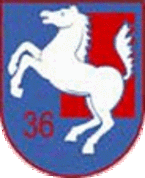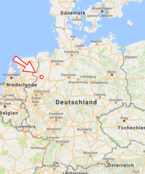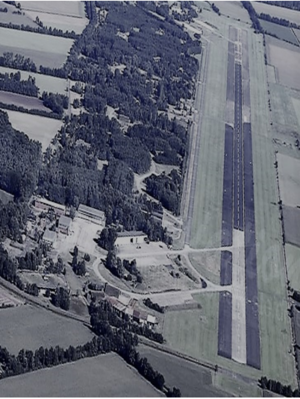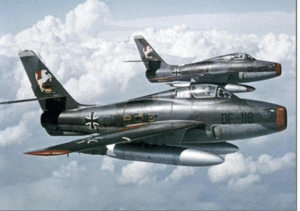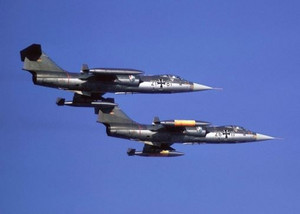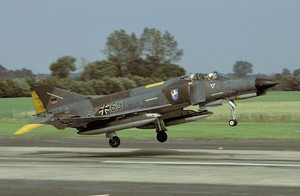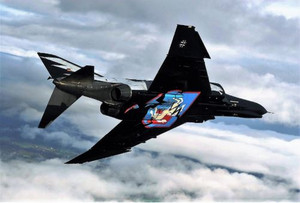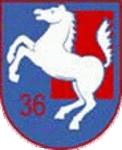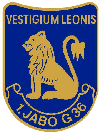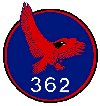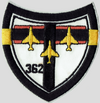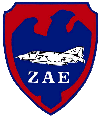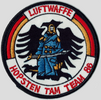FBW 36 "W"
The „Westphalia“ Wing
Fighter Bomber Wing 36 “W”
History of Hopsten Airbase, the home of the Westphalia Wing
52°20´40´´ North / 7°32´30´´ East: These are the location coordinates of Hopsten airbase, from 1961 on the home base for the „Westphalia Wing“
Construction work for a military airbase started in 1938 on territory belonging to the town of Dreierwalde. A 6000 Feet (ft.) long main runway in east – west direction was complemented by two 3300 ft. long runways in north – south and northeast – southwest directions. After completion in 1940 the town of Dreierwalde refused to lend its name to the new airbase. Only after extension of the main runway to a length of 10 000 ft. on territory belonging to the town of Hopsten the base gained its name „Hopsten Airbase”.
Initially, Hopsten was not an important airbase, but this changed in 1944 when the location grew ever more important for the air defense of the „Reich“. Until the end of WW II it was used by Messerschmitt 109, Focke-Wulf 190 and Messerschmitt 262 fighter aircraft, Messerschmitt 110 and Heinkel 219 night fighters, as well as Arado 234 reconnaissance/bomber aircraft. Due to the importance attributed to the Messerschmitt 262 and Arado 234 jets and their vulnerability during takeoff and landing, the base was protected by approximately 500 air defense guns and numerous conventional fighter squadrons in the vicinity.
On 6 April 1945 the base was handed over to the British without resistance. As German troops had rendered it unusable for flying operations before, the British decided not to reactivate the base, instead giving it to the local population for agricultural use.
A new start after World War II
Approximately ten years after the end of WW II, the Federal Republic of Germany in 1956 started to again build up military forces as part of the Western Alliance. It took three years until the Federal Ministry of Defense in 1959 decided to construct a new airbase on 750 acres of the WW II Hopsten airfield.
NATO-financial resources were used for the construction of a completely new airbase according to modern NATO-Standards with an 8000 ft. long and 90 ft. wide runway in north – south direction. The base with all operational facilities was located on territory belonging to the towns of Dreierwalde and Hopsten, as well as Hörstel. In accordance with NATO-Standards the housing and administrative facilities were located in the town of Rheine, about 8 km away. The new airbase was again named Hopsten airfield and it was to be the home of the „Westphalia” wing with the initial unit designation of Fighter Bomber Wing 36.
The „Westphalia“ Wing is born
The history of the wing can be separated into three phases:
- the Republic F-84F “Thunderstreak“ era 1961 - 1965
- the Lockheed F-104 G “Starfighter“ era 1965 - 1975
- the McDonnell-Douglas F-4 F “Phantom II“ era 1975 – 2005, with two designation changes:
Fighter Wing 72 „Westphalia“ starting 01 Jan 1991 and
Flying Training Center F-4 F“ starting 31 Jan 2002.
The Republic F-84F “Thunderstreak“ era
On 12 December 1961 Fighter Bomber Wing 36 was officially commissioned by Luftwaffe Chief of Staff Lieutenant General Kammhuber. At that point, only the 1st Flying Squadron (Sqn) with the mission of Close Air Support (CAS) was operational. A few weeks later, on 19 January 1962 the 2nd Sqn was activated. Its primary tasks were familiarization of US-trained F-84 F pilots with European weather conditions and initial weapons qualification. To support these tasks, the 2nd Sqn. received six T-33 A and two Piaggio P-146 D aircraft. Only three months after official commissioning, on 30 March 1962 the wing suffered the loss of its first aircraft and pilot.
Things now were developing fast. After most of the buildings in the Rheine barracks were completed, on 16 June 1962 the wing held its first open house. An incredible 150 000 visitors were counted on the occasion. Effective 13 March 1963 the conceptual design for the new wing´s emblem was accepted by the Luftwaffe: It depicts a rearing white Westphalian horse over red and blue background, with blue standing for the sky and red for the Westphalian earth. From now on, this emblem graced all aircraft of the wing, irrespective of all organizational changes.
From 12 until 28 June 1963 the wing hosted the first „NATO Tactical Weapons Meeting“ on German soil. Fighter-Bomber pilots from six NATO nations participated in the exercise and 220 sorties were flown. Especially worth mentioning is the fact, that the wing at this early stage was able to organize such an exercise, while at the same time deploying a contingent to Decimomannu / Italy and conducting full local flying operations.
Already on 22 June 1964 a turning point for FBW 36 cast its shadow: On the occasion of the open house a F-104 G Starfighter of FBW 31 from Nörvenich airbase was displayed. This new generation aircraft would soon replace the F-84F Thunderstreak at Hopsten as well.
In less than five years 50 000 flying hours were accumulated with the F-84F, but eight pilots lost their lives due to accidents.
The Lockheed F-104 G “Starfighter“ era
On 2 February 1965 the supersonic age began for FBW 36: The wing commander, Colonel Kmitta, landed the first „Hopsten Starfighter“ with the serial number DF-101. It then took two years to reach the full complement of 52 aircraft. Only in December 1967 the wing was again assigned to NATO.
Also in 1967, with the new NATO-Doctrine of „Flexible Response“, the 1st Sqn. was assigned a nuclear (Strike) role. From this point on two F-104 G aircraft, each loaded with a nuclear bomb, were held on continuous 24 hours Quick Reaction Alert (QRA). In conjunction with this, a 100 head strong US Air Force (USAF) unit, tasked with protection and eventual release of the nuclear weapons now was part of the wing. The nuclear “Strike” role for FBW 36 was abandoned again in early 1972, and the unit reverted back to a conventional fighter-bomber role.
A neither strategic nor even tactical event occurred on 5 January 1969, when the band “Starfighter 36” was founded. Personnel of FBW 36 were proud of it, as the band soon gained an excellent reputation not only within the Luftwaffe, but within the whole German Armed Forces and in the civilian environment as well.
In September 1971 a three-month deployment to Beja airbase in Portugal was required due to runway repair work at Hopsten. The re-deployment back to Hopsten happened just in time for the wing’s 10-year anniversary and coincided with the achievement of 50 000 flight hours with the F-104 G. In 1972, the Piaggio 149 D liaison aircraft were replaced with the Dornier Do-28, which was amicably christened as “Farmers Eagle” by the aircrew.
At this time there were already indications that the era of the “Starfighter” would after 10 years come to an end. The successor was already known: The McDonnell Douglas F-4 F “Phantom II”
During the “Starfighter era” the wing accumulated 100 000 flight hours and lost 7 pilots due to accidents.
- The previous single seat pilots had to adapt to the „two-men-concept“, an aspect not to be underestimated.
- The implementation of the air defense QRA mission required infrastructural as well as personnel / training adaptations.
After the conversion was completed in July of 1976 the wing was again assigned to NATO’s 2nd ATAF. In July of 1977 the already fourth open house of FBW 36 on the occasion of the wing´s 15th anniversary drew almost 200 000 visitors. During these 15 years the wing accumulated 173 000 hours.
The McDonnell-Douglas F-4 F “Phantom II“ era
On 4 February 1975 the first F-4 F (37+97) for FBW 36 was flown into Hopsten by the wing commander Colonel Schwenke and his back seater Major Kroll. The conversion to the new weapons system brought several changes:
- Military and civilian personnel strength increased from 1800 to 2300.
- Air defense was added to the existing ground attack role, initially as a secondary role.
- The previous single seat pilots had to adapt to the „two-men-concept“, an aspect not to be underestimated.
- The implementation of the air defense QRA mission required infrastructural as well as personnel / training adaptations.
After the conversion was completed in July of 1976 the wing was again assigned to NATO’s 2nd ATAF. In July of 1977 the already fourth open house of FBW 36 on the occasion of the wing´s 15th anniversary drew almost 200 000 visitors. During these 15 years the wing accumulated 173 000 hours.
As a distinction for all personnel of FBW 36 in 1979 the wing received both the 3. Luftwaffe Division award for best performance and the German Armed Forces flight safety award.
In 1980 FBW 36 was tasked with a special mission: As first German unit, the wing deployed with 6 F-4 F aircraft and 95 personnel from 21 July to 26 September to Goose Bay, Labrador for extreme low level training. This first deployment was conducted by way of so called “island hopping” with intermediate stops in Lossiemouth (Scotland), Keflavik (Iceland) and Sondrestroem (Greenland) before reaching the 5000 km distant Goose Bay. The following yearly deployments were conducted non-stop with the support of US Air Force tanker aircraft. It was during operations from Goose Bay on 22 September 1980 that the wing lost its first F-4 F and its crew.
The requirement to standardize all F-4 F training led to the establishment of a centralized training facility (ZAE) F-4 F for the Luftwaffe at Hopsten on 1 February 1981. On 1 January 1984 this centralized facility officially gained squadron status as a separate, third flying squadron of the wing.
On 20 September 1981 the fifth open house drew 100 000 visitors, even though for political reasons the wing was not allowed to fly any of its aircraft. So, the highlight of the day was an acceleration contest between two Honda motorcycles, a Porsche 911 Turbo and an F-4 F. And who won? Naturally the Phantom!
On 1 April 1984 the scope of tasks grew again: The new ATV-Group F-4 F, responsible for evaluation, testing and procedures, from now on formed part of FBW 36. Its personnel were disciplinary subordinated to the wing commander, but functionally the ATV-Group was directly responsible to Luftwaffe Operations Command. Such an ATV-Group for the F-4 F was long overdue, as every other weapons system of the Luftwaffe had one. Two of its more important tasks were evaluation and introduction into service of AGM-65 B and D Maverick missiles in 1986/87 and evaluations of AN/APG 65 radar and AIM-120 AMRAAM missile in 1991 and 92. The latter were conducted at Point Mugu in California in cooperation with the German Armed Forces Technical Center WTD-61.
In May of 1984 a special honor was bestowed on FBW 36. In recognition of the wing’s strong bonds to its home region it was awarded the heritage name of „Westfalen“ (Westphalia) by the Ministry of Defense. The official wing designation was now “Jagdbombergeschwader 36 “Westfalen” (Fighter Bomber Wing 36 “Westphalia”), or short JaboG 36 “W” (FBW 36 “W”). In addition, on 17 September 1984 the local county of Steinfurt took on a sponsorship for JaboG 36 „W“.
And then, suddenly, everything changed with the fall of the Wall and German unification, and FBW 36 “W” felt the effects as well.
As a result of these changes, in October 1990 the leadership of the Luftwaffe decided to equip and assign both F-4 F fighter-bomber wings 35 and 36 „W“ exclusively for the air-to-air role. As the airfields of former East Germany were not usable without infrastructural improvements, from October 1990 on 4 F-4 F aircraft from FBW 35 and 36 „W“ were deployed to Fassberg airbase close to the former Inner-German border. From there, they were to guard the sovereignty of the East German airspace. However, for various reasons this arrangement did not work very well, and therefore the QRA in December 1990 was relocated back to Hopsten. As a consequence of its changed role, the wing was renamed and gained the fighter wing denomination „Jagdgeschwader 72 Westfalen“ (Fighter Wing 72 “Westphalia”), in short JG 72 „W“ (FW 72 „W)“, on 1 January 1991.
At this time, rumors already spread concerning the relocation of FW 72 “W” to Laage airbase, close to Rostock in former East-Germany. These rumors were nurtured, when on 5 March 1991 the wing commander Colonel Menge landed with a MiG-29 at Hopsten. At the time, he was also commander of the former East-German base of Preschen and held - as one of the first Luftwaffe pilots - a MiG-29 license. On 24 May 1991, what were before rumors changed into certainty: FW 72 „W” and its F-4 F aircraft were to relocate to Laage airbase in order to form a new mixed wing with MiG-29 aircraft from Preschen.
Although the wing´s personnel (and their families) understandably did not feel like celebrating, FW 72 „W“ none the less celebrated the wing´s 30th anniversary with a big open house. Many of the visitors were grieved by the imminent loss of their “Westphalia” wing.
But then, in April 1993 everything changed again, as the Luftwaffe re-considered and decided to leave FW 72 „W“ at its Hopsten base. Now it seemed assured that the wing would remain in the region for the long-term. The closure of the 3rd flying Squadron in February 1995 was the price to pay; its tasks were taken over by the 2nd Squadron.
The next outstanding event was the participation in „Roving Sands“, the biggest multinational air defense exercise of the world, with 15 000 soldiers of various nations participating. For this exercise over the “White Sands” desert of New Mexico, FW 72 „W“ deployed six F-4 F aircraft with over 100 personnel to Cannon AFB in May of 1996.
Three months after returning from this exercise, on 8 September 1996 the wing celebrated its 35th anniversary with a beautifully painted Phantom. For the occasion, the image of a noble Westphalian steed covered the whole fuselage of an F-4 F.
Only a couple of weeks later, FW 72 „W“ participated in exercise „Red Flag”, flying out of Nellis AFB in Nevada. The wing was the second Luftwaffe unit that took part in this high value exercise.
1997 brought a new challenge with the decommissioning of the German F-4 E aircraft at Holloman AFB in New Mexico. In order to be able to continue training in the USA, 24 F-4 F aircraft had to be ferried to Holloman in several waves from January to November 1997. These machines were pulled together from several German wings and were concentrated for their ferry flights at Hopsten.
The following years again brought participations in exercises „Red Flag“ and „Maple Flag“ as well as the routine yearly deployments to Decimomannu and Goose Bay. In summer 2000 a complete overhaul of the runway necessitated a relocation to neighboring Twenthe airbase in the Netherlands. The opportunity was also used to build a new air traffic control tower, a new chow hall and gas station, and to exchange the hangar doors as well. Considering what was to come, a prime example of truly farsighted planning and use of tax payers’ money!
The 9th open house on the occasion of the 40th anniversary already was overshadowed by the coming developments. With the implementation of the 5th Luftwaffe structure the dissolution of Jagdgeschwader 72 „Westfalen“ became a certainty. On 7 January 2002 the last QRA mission was flown. Only a couple of days later, on 18 January 2002, the 1st Flying Squadron was disbanded: The wings’ operational mission, air defense, was history!
The personnel of the 2nd Squadron was spared the same fate, as it virtually in the last minute regained its old mission: Adaptation of US-trained aircrews to European weather and airspace conditions, and F-4 F instructor training continued until 2006. However, the wing Jagdgeschwader 72 “Westfalen” was officially dissolved on 31 January 2002. At the same time, its successor “Fluglehrzentrum F-4 F” (Flight Instruction Center F-4 F) – consisting mostly of the previous 2nd Sqn. - was commissioned. In line with this, the number of aircraft was reduced to 22 and personnel strength declined to under 1000 soldiers and civilians
Even though it was decided to close the base by mid-2006, in the years up to then individual crews continued to participate in exercises, flying displays and such.
Flying operations were finally terminated on 15 December 2005, when after a solemn ceremony the four last F-4 F aircraft took to the sky from Hopsten airfield.
During the F-4F Phantom era 230 000 hours were flown; 5 aircraft were lost due to accidents with 6 aircrew members killed.
Social Aspects
Most members of the „Westphalia“ wing integrated themselves into the life of their garrison town Rheine and the surrounding communities, for example in sports clubs or local politics. Most stayed true to the region even after retirement.
The decommissioning of the wing and the closure of the barracks after more than 45 years had a very negative effect on these communities, especially because other Armed Forces installations had already been closed before. The decisions were hard to understand, as in contrast to other airbases, in the Hopsten vicinity no protest movement against aircraft noise had ever formed, even though the wing had an unusual amount of flying activity due to its training mission.
And only a few years later with the helicopter regiment at Rheine-Bentlage the last big military installation of the entire region was closed, in spite of alleged promises not to do so by the Ministry of Defense, and despite of heavy protests by the population.
The result was, that one of the biggest German Armed Forces garrisons was during a very short time span reduced to zero: Whatever the reasons for these decisions, in the eyes of those that were affected by them they manifested an utter contempt for the interests of local communities and population by the military and political leadership! Those communities over decades had accepted the burdens of military flight activity and had been exemplary hosts for the local military units!
Original German text and pictures by Heinz Roschmann
English translation by Jürgen Erbeck



